
Can your knowledge of volcanic rocks make you rich? Yes!! That is, if you combine it with knowledge of mineral deposits and global economic factors. Volcanoes directly or indirectly produce or host deposits of aluminum, diamonds, gold, nickel, lead, zinc, and copper. We use most of these materials everyday and, over the course of a lifetime, consume some of them (via the products we buy and use) in great amounts.
The drop downs below have information on a few economically significant minerals (though bauxite isn't really a mineral). Information on some of our favorite rock types is in the menu above. These are provided to assist the student in preparation for the example quiz provided below.
Above: Photo shows alluvial diamonds that were eroded from the Argyle pipe. Photo courtesy of Grant Boxer.
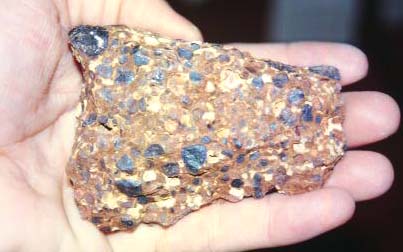
Aluminum ore, called bauxite, is most commonly formed in deeply weathered rocks. In some locations, deeply weather volcanic rocks, usually basalt, form bauxite deposits. This sample of bauxite ore is from Western Australia.
Aluminum has a wide range of common uses. It is lightweight, strong (especially with alloys), and conducts heat well. Many kitchen items (pots and pans, foil, dishes) are made of aluminum. Most materials used for transportation use large amounts of aluminum: cars, trucks, boats, aircraft, and aircraft engines. Road signs and high-voltage power lines are also made mostly of aluminum.
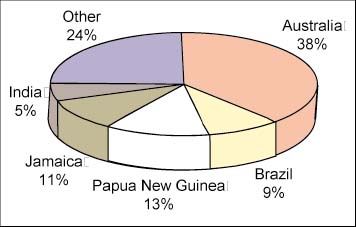
About 110 million tonnes of aluminum was produced in 1994. Australia produces most of the world's aluminum. Diagram from ITAM Bauxite by the Minerals Council of Australia.
Deposits of nickel sulfides are mined from greenstone belts in many ancient volcanic terranes. The ore is associated with ultramafic lava flows called komatiites. Komatiites have more than 18 weight % magnesium oxide (MgO) and large amounts of the mineral olivine. Komatiites are derived from melting in the mantle.
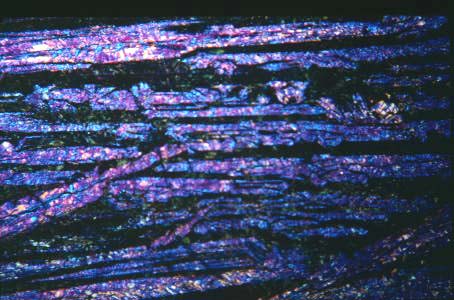
Komatiites have a unique texture called spinifex. The texture is an intergrowth of long, skeletal crystals of olivine and/or pyroxene. The texture is named for its resemblance to spinifex grass in Australia. Photo courtesy of Rob Hill, CSIRO.
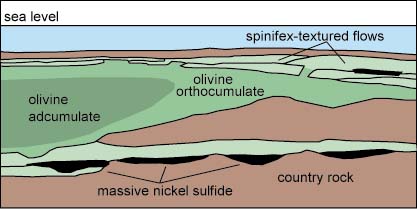
Cross-section of a typical komatiite lava flow.
Simplified from Hill and others, 1989.
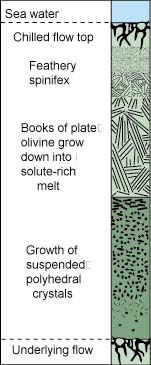
Cross-section of igneous lithologies and associated massive nickel sulfides in a komatiite lava flow.
Simplified from Hill and others, 1989.
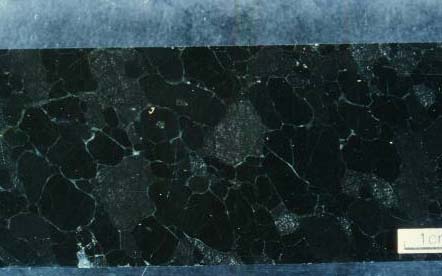
Core in komatiite lava with adcumulate texture.
Photo courtesy of Rob Hill, CSIRO.
Nickel is commonly alloyed with other metals to provide resistance to corrosion and heat, and to add strength and hardness. These alloys are used for industrial and consumer goods. Most of the nickel produced is used to make stainless steel. Stainless steel contains about 8% nickel. Monel metal, a highly corrosion-resistant alloy, contains 67% nickel and is usedin ship building, food-processing equipment and in hospitals. Nickel is used by the military for armor plate. Nickel is used in alkaline batteries, dyes, insecticides and as a catalyst. Nickel is commonly used in coins.
The Sudbury District in Canada is the world's largest producer of nickel.
Another major nickel producer is in Western Australia and includes the Kambalda and MurrinMurrin deposits. MurrinMurrin consists of five deposits with a total of 11.9 million tonnes at 1.01% Ni and 0.07% Co.
In 1993, a large deposit of nickel-, copper-, and cobalt-sulfides (~150 million tons) was discovered at Voisey Bay on the northeast coast of Labrador, Canada. This deposit formed in magma chambers that fed large basaltic eruptions.
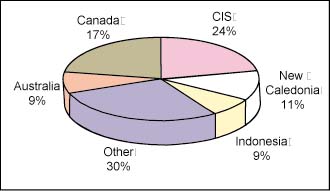
In 1994, about 875,000 tonnes of nickel was produced worldwide. Major producers are the Commonwealth of Independent States (former Soviet Union), Canada, New Caledonia, Indonesia, and Australia. Diagram from ITAM Nickel by the Minerals Council of Australia.

Photo shows gold jewelry recovered from the ash deposits of the 79 A.D. eruption of Vesuvius.
Gold forms in close association with volcanoes or is hosted in volcanic rocks. Three environments/styles are most common: gold in greenstone belts, gold in porphyry deposits, and gold in epithermal deposits.
Gold is found in Archean (rocks older than 2.5 billion years) greenstone belts in Australia, southern Africa, and Canada. Greenstone belts are volcanic-sedimentary sequences, which include ultramafic rocks, dolerite, basalt, chert, sandstone, shale, tuff, banded iron-formation and other rock types. These rocks are very complex, having undergone metamorphism, folding, faulting, and shearing. Gold is most commonly found along the edges of greenstone belts and associated with structural features. Intensely altered and fractured basalt is a common host rock. The gold is though to be mobilized by hydrothermal solutions during regional metamorphism. The solutions probably contain only a few parts-per billion gold but great volumes of solution can precipitate their gold in a small zone with favorable chemical conditions. The deposit itself is usually a quartz vein that carries the gold or adjacent altered rock.
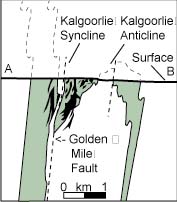
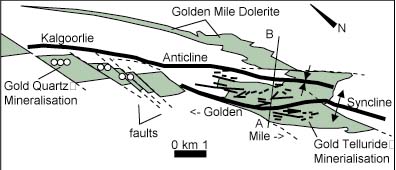
A classic example of gold hosted in greenstone is the Golden Mile in Kalgoorlie, Western Australia. The top diagram is a simple map that shows folds, faults, rock type, and mineralization. The bottom diagram is a cross-section of the deposit. Dolerite refers to dike rocks with plagioclase crystals in pyroxene crystals. By 1993, 40 million ounces of gold has been mined from the Golden Mile. Diagram from ITAM Gold by the Minerals Council of Australia.
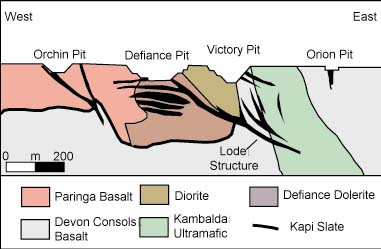
Another example of gold hosted in greenstone is the St. Ives deposit near Kambalda, Western Australia. Three mines have produced more than 2.1 million ounces of gold from 1980-1993. Another 5.4 million ounces of gold remains in the deposits. The gold is found in altered rocks in all parts of the stratigraphic sequence. Diagram from ITAM Gold by the Minerals Council of Australia.
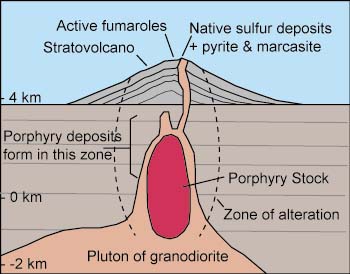
Gold and copper are found in ore bodies associated with porphry. Porphry is a general term applied to igneous rocks of any composition that contain conspicuous phenocrysts (crystals) in a fine-grained groundmass. The term is from a Greek word for purple dye and was first applied to a purple-red rock with phenocrysts of alkali feldspar that was quarried in Egypt. Diagram from ITAM Copper by the Minerals Council of Australia.
This type of deposit forms beneath stratovolcanoes and is associated with subduction zones. Erosion strips off overlying rocks to expose the mineralization. Gold and copper are found in sulfide minerals disseminated throughout the large volumes of intrusive rock (strictly speaking, this ore is associated with volcanic systems, usually not the volcanoes themselves). This requires large amounts of rock to be mined, often in open pits. The deposits are commonly 3-8 km across and copper may be less than 1% of the rock. Porphyry deposits are zoned in alteration (potassic ® sericitic ® argillic ® propylitic) and mineralization.

Epithermal refers to mineral deposits that form in association with hot waters. The deposits form within 1 km of the surface and water temperatures are about 50-200 degrees C. Shallow bodies of magma supply heat. The rising hot water carries dissolved gold and other elements. The water boils about 300 m below the surface and hydrogen sulfide gas escapes. This causes the gold to precipitate. The boiling zone is the target for mineral exploration. Veins commonly host the economic minerals. Diagram from ITAM Gold by the Minerals Council of Australia.
Lihir Island in Papua New Guinea
Lihir Island is an epithermal deposit discovered in 1982. The island is made of three volcanoes including Luise caldera, where the deposit formed. The rocks are trachybasalt lava flows, breccia, and tuffs.The mineralized rocks are highly altered. Most of the ore is in breccia thought to have been a boiling zone for rising fluids. The deposit formed between 350,000 and 100,000 years ago. It is estimated that the deposit contains 21.3 million ounces proven and probably another 42 million ounces as a geological resource. Most of the gold is fine particles in pyrite (FeS) grains. Hot springs and fumaroles are still active on the caldera floor.
Gold is rare, durable, chemically inert, and beautiful. These qualities make it useful for monetary exchange and investment, jewelry, and art.Gold’s high electrical conductivity, malleability, and ductility make it useful as an industrial metal. Gold is alloyed with silver, copper, nickel, palladium, zinc, and titanium to increase its tensile strength. Note: for gold, 1 carat = 1/24 part. Pure gold is 24 carat.
Below is a pie diagram of major gold producers. In 1994, 2,296 tonnes of gold was produced. South Africa is the largest producer, followed by the USA, Australia, and the CIS (former Soviet Union). Diagram from ITAM Gold by the Minerals Council of Australia.
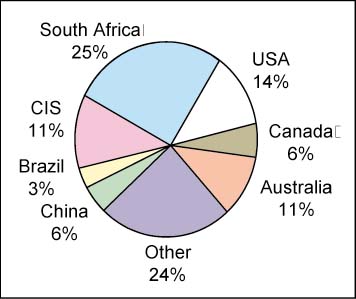
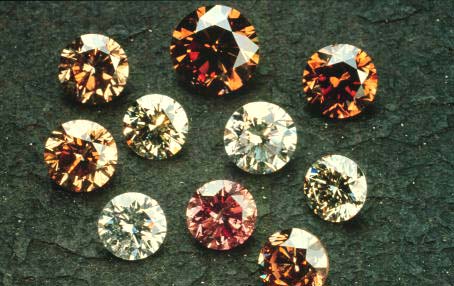
Diamonds are crystalline carbon and the hardest known substance.
This photo shows diamonds from the Argyle Mine in northern Western Australia.

Diamonds are brought to the surface from the mantle in a rare type of magma called kimberlite and erupted at a rare type of volcanic vent called a diatreme or pipe. Kimberlite is a gas-rich, potassic ultramafic igneous rock that contains the minerals olivine, phlogopite, diopside, serpentine, calcite, and minor amounts of apatite, magnetite, chromite, garnet, diamond, and other upper mantle minerals. Upper mantle xenoliths are found in some kimberlite and provide clues to the magma's origin. The source depth for kimberlite magmas is estimated at 200 km, more than twice as deep as the source region for most magmas. At a depth of 200 km the pressure is 60,000 times greater than the surface and the temperature is about 1500 C. Kimberlite magmas are rich in carbon dioxide and water which brings the magma quickly and violently to the surface. Most kimberlites occur as multiple intrusive events. Kimberlite was named for the rock associated with diamonds in Kimberley, South Africa.
Left: Simplified from Hawthorne (1975).
Kimberlite magmas form "pipes" as they erupt. A tuff cone is at the surface and formed by base-surge deposits. In the subsurface, a funnel-shaped body narrows to a depth of hundreds of meters. The pipe (also called a diatreme) is filled with kimberlite, with or without diamonds (only 1 in 5 of the pipes at Kimberley contain diamonds).
Just how many diamonds are needed to make aa pipe economical? Some South African mines operate at 25 carats of diamond per 100 cubic meters of rock or about 2 grams of diamonds per 100 tons of rock. Because diamond has a specific gravity of 3.5 grams per cubic centimeter, 1 cubic centimeter of diamond weighs 16 carats. Picture a giant 100-ton ore truck full of kimberlite - that truck contains only half of a cubic centimeter of diamonds! Only about 35% of those diamonds are gem quality.
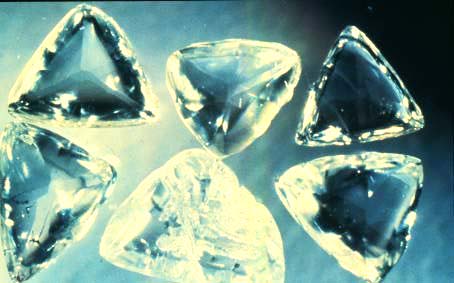
Macles diamonds from the Argyle pipe, Western Australia.
Photo courtesy Grand Boxer.
Most diamonds are used in drill bits and diamond tools. A small number are used for glass cutters and surgical instruments. Only the finest are used as gems.
Australia is currently the world's largest producer of diamonds. Most of these diamonds are low quality and used for industrial purposes. Most of the diamonds are from the Argyle diamond pipe in northern Western Australia. The pipe at Argyle is made of lamproite, not kimberlite. The mine produced 27.8 million carats (1 ct = 200 mg; 5 carats = 1 gram) of low grade diamonds in 1993-1994. Because of the high rate of production at Argyle, mining operations will end within the next few years. The mines at Kimberley, South Africa have produced a total of more than 200 million carats since the 1870s. About half of South Africa’s diamonds are gem quality.
Zinc-Copper volcanogenic massive sulfide (VMS) deposits have been observed as they form at mid-ocean ridges. Chimneys formed at the ridges have as much as 29 weight % zinc and 6 weight % copper in sulfide minerals (pyrrhotite, pyrite, sphalerite, and chalcopyrite). The minerals are dissolved in fluids at temperatures as high as 380 C flowing at 1-5 m/sec.
The minerals precipitate as the hot solution comes in contact with cold sea water. Photography courtesy of Woods Hole Oceanographic Institution and members of the Adventure dive (Principle Investigators: D. Fornari, R. Haymon, K. Von Damm, M. Perfit, M. Lilley, and R. Lutz).
Lead, zinc, and cooper are found in VMS deposits. The deposits form in deep ocean water by the precipitation of sulfide minerals released by submarine volcanoes.
Volcanic fluids and hot seawater move through the volcanic rocks and leach metals. The deposits are associated with lava flows, breccia, water-deposited tuffs, cherts, sulfates, and limestones. VMS deposits are usually associated with quartz, anhydrite, gypsum, and barite. This photo shows pyrite in silicified tuff from a VMS deposit in eastern Java, Indonesia. The sample contains 0.55 ppm gold.
| Zinc-Copper | Lead-Zinc-Copper | Copper-Pyrite | |
|---|---|---|---|
| Host Rock | Basalt to Rhyolite | Rhyolite | Basalt or Ultramfic Lava |
| Age | Archaen | Proterozoic-Paleozoic | Mesozoic |
| Ore Minerals | Sphl, Chpy, Py | Gal, Sphl, Py, +/- Chpy | Chpy, Py |
| Associated Metals | Gold, Silver | Silver +/- Gold | Gold |
| Famous Occurrences | Greenstones of Canada and Austrailia | Sudbury and Bathurst Canada | Kuroko, Japan |
| Setting | Spreading Centers | Back-arc basins | Spreading Centers |
Minerals: Sphl = sphalerite, Chpy = chalcopyrite, Py = pyrite, Gal = galena
Kuroko-style
The deposit at Bathurst in Canada is an example of lead-zinc-copper VMS. Hydrothermal solutions associated with Keweenawan flood basalts have produced copper deposits in the Lake Superior area. Between 1845 and 1968, over 13 billion pounds of copper and 16 million ounces of silver were produced from the Keweenawan district.
The porphry (not VMS) mine at El Abra in Chile will produce 500 million pounds of copper annually.
Copper was used as long ago as 8000 BC for tools, weapons, and ornaments. The discovery of bronze (copper and tin alloy) about 3500 BC marked the onset of the Bronze Age. Romans used lead for the plumbing and sewage systems. In Modern times, the electrical conductivity, ductility, and resistance to corrosion of copper, lead, and zinc, make them very useful in alloys. Copper is used for electrical applications (50%), general and industrial engineering applications (20%), building and construction (15%), transportation (11%) and other applications. Lead is used in storage batteries, paints, dyes, explosives, insecticides, and rubber products.
Zinc is used in galvanized steel, protective coatings for steel, and die casting. Zinc compounds are used for luminous dials, cosmetics, plastics, rubber products, soaps, and inks.
In 1991, 9,167,000 tons of copper was produced. Chile (19.8%), USA (17.8 %), and the CIS (9.8%) are the main producers. USA, Japan, and the CIS are the main consumers.
These links provide an example quiz based on the information above. These can be adapated for your classroom as needed.